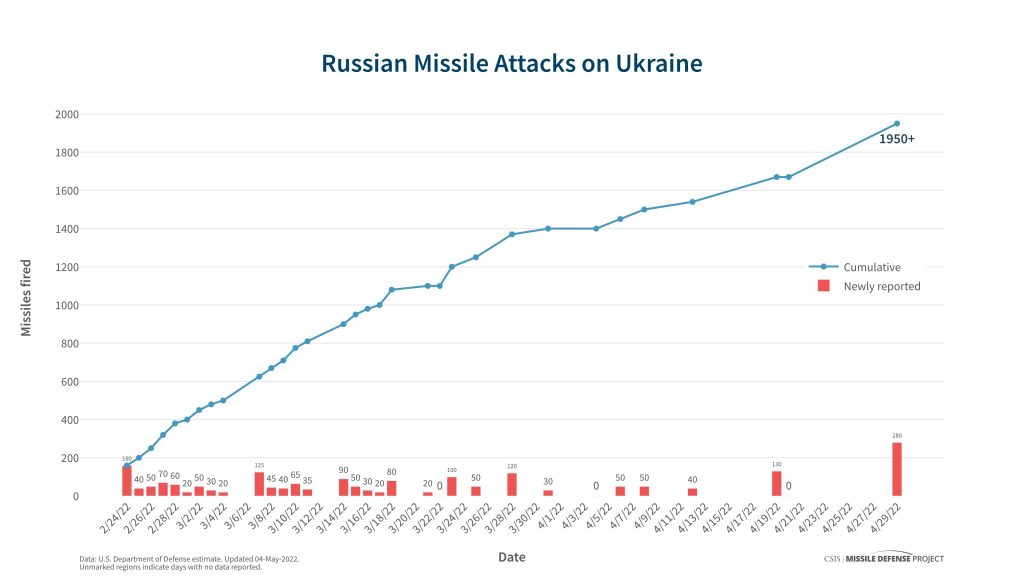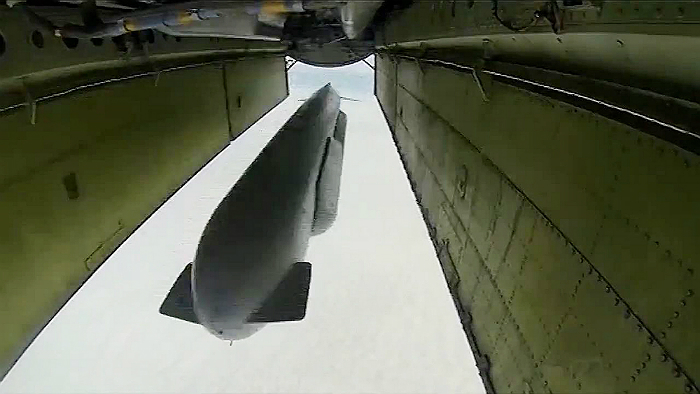Almost two month passed since we published our analysis of what missiles russia used against Ukraine since the beginning of full-scale invasion on February 24.
So what have we seen during this time?
Russia launched more than 2,200 various cruise and ballistic missiles since the start of the full-scale invasion of Ukraine. Talking about the daily count of missile launches, it has been dropping gradually from 160+ launches a day since February 24 to the modest ~20 and fewer launches a day. Moreover, since May 2022 the russians have been performing missile land strikes with impressively old weaponry : cruise missiles Kh-22 (AS-4 Kitchen by NATO classification). For sure, these missiles are despairing screams and bright evidence of a severe lack of modern missile weaponry.
These three months of fierce Ukrainian resistance busted a number of myths about Russia, its military technologies, and its armed forces.
The main one is a powerfully hyped by the russian propaganda myth about “almighty russian missiles”
Russia have repeatedly and loudly stated that their various cruise and ballistic missiles are so high-precise, massive in numbers, and destructive that the army and infrastructure of Russia’s potential enemies will inevitably be destroyed. However, the practice of full-scale war has revealed all the hidden flaws.
As of May 4, the Russian Federation has used more than 1,950 missiles of various types since the beginning of the full-scale war against Ukraine according to the information by the US DoD. To date, this figure has roughly exceeded the mark of 2,200+ missiles fired. However, up to 60% of the launched missiles, depending on the type, suffered technical malfunctions and miss their targets completely.

The initially high daily count of missile launches also decreased significantly. Starting February 24, russia was launching 160+ missiles per day. But now the russian military chiefs can only dream about such a high tempo of missile strikes: it plummeted to only about 20 or fewer missiles per day and is quite irregular.
Russian “3-days long special military operation” is still dragged on towards its defeat
Due to the fierce and effective resistance of the Armed Forces of Ukraine, the enemy’s “three-day special military operation” did not achieve any of its goals. The stockpiles of missile weapons in the scope of this “operation” were quickly depleted, but the target list is growing rapidly. Therefore, the Russians are forced to look for additional non-specific or obsolete missiles to hit ground targets.
The dynamics of changes by time in the types of missiles used by russian forces:
- About 40% of all launched missiles in the first month of the russian invasion were short-range ballistic missiles 9M723 Iskander-M missiles, another 33% were 3М-14missiles of the Kalibr cruise missile family, and 27% were other types.
- Russia used both Iskander and Kalibr systems widely in February-March, but minimally uses both types today;
- Since the third week of the full-scale invasion, Russia has been using the outdated 9M79M Tochka-U tactical ballistic missile. Despite the official “decommissioned” status of this system, the Russians are forced to use “Tochka’s” to spare truly long-range systems used to disrupt logistics and production in the areas, far from the frontline;
- Today, in fact, Russia’s only instrument for striking targets all around Ukraine is the and Kh-555 та Kh-101. cruise missiles. Moreover, Russia uses them exclusively from the strategic bombers Тu-160 and Тu-95МS, so the intensity of their launches is limited by the complexity and high cost of operation of strategic bombers;

- Since March 18, 2022, the russians have been using the supersonic universal anti-ship cruise P-800 Onyx missile, launching from the mobile complexes Bastion-P in the Crimea targeting ground targets in the Odesa region. Comparing the P-800 to Kh-555 or 3M14 cruise missiles, it carries a smaller in the half warhead, can reach only a 300 km range, and is less effective against land targets;
- From March 20 forward, Russia occasionally uses the Kh-47M2 Kindzhal(which is actually an air-launched modification of the 9M723 Iskander missile). This kind of ballistic missile was produced in small quantities and is powerfully hyped by russian propaganda;
- Finally, on May 8-9, 2022, the Russians deploy Kh-22/Kh-32 missiles, launched from strategic bombers Tu-22M3 to hit ground targets in Ukraine. Launches of these obsolete and extremely dangerous to operate missiles unequivocally signals the enemy’s shortage of modern missile weapons.
Why the use of Kh-22 cruise missiles is a sign of depletion of stockpiles of other, more advanced, missile weapons in Russia?

- Truly ancient piece of missile technology in all aspects
The development of this system began in June 1958, and in 1967 was entered service by the Long-Range Aviation of Soviet Air Forces. During the production period of this missile, about 1,000 missiles were made and eight modifications were created. At the present time, the only modification Kh-22NA is available to perform ground target strikes from russian Tu-22M3.
Back in the 60s, the main targets for these missiles were defined as aircraft сarrier battle groups, individual large ships, or massive ground targets (like plants or districts). In modern Russia, formally, Kh-22 missiles should be replaced by “new” Kh-32 missiles to launch with Tu-22M3M bombers. But the modernization of the Tu-22M3 fleet to the level of the Tu-22M3M is severely delayed, as well as the rearmament of the Kh-32 (refurbished and upgraded Kh-22, in fact). Literally, only a couple of Tu-22M3M bombers were ready at the time of a full-scale Russian attack on Ukraine.
2. Heavy, overcomplicated and aged military missile technologies
First of all, they are extremely heavy: it’s weight might be up to 6000 kg and more. Also, Kh-22 cruise missile family is equipped with liquid-fuel rocket engines, consuming TG-02 (Tonka-250) as fuel and IRFNA (inhibited red fuming nitric acid) as an oxidant. Hello, wunderwaffe programs of Nazi Germany back to WWII times!
Moreover, due to the aggressive and dangerous combo “fuel+oxidant”, this missile must be fueled prior to takeoff of the bomber. To fill this missile with several tons of toxic and corrosive substances this process is performed in special protective suits and insulating gas masks, controlling possible leaks of rocket fuel components with a gas analyzer. For sure, such a complex maintenance process greatly increases the probability of accidents, catastrophes, and a negative increase in the numbers of enemy aviation specialists.
3.Nowadays, in 2022, these missiles are hopelessly outdated, even in their main role – as anti-ship weapons.
The Kh-22’s active radar homing head is able to detect and capture a radio-contrast target sizewise like an aircraft carrier. However, back in Soviet times, the electronics of this missile system were rendered primitive and vulnerable to electronic countermeasures of the potential enemy. So much vulnerable that the Soviets were forced to train a variant of the aircraft carrier battle group attack with the preventive nuclear strike by nuclear-capable Kh-22 in the area of the target to disable the EW systems before salvos of conventional Kh-22.
Some notes about the land target strike capabilities of Kh-22. The inertial guidance system of this missile provides accuracy “plus or minus a couple of aircraft carriers”. The missile is not accurate for non-nuclear weapons at all. This accuracy is acceptable for missiles with a nuclear warhead but is totally unacceptable for missiles with conventional warheads. And certainly not “high-precision strikes without any collateral damage, only military objects are targeted” style russia claimed it to be.
Russia in despair
The fact that the russian army has deployed Kh-22 cruise missiles to perform land target strikes: these missiles are obsolete, very inaccurate and dangerous to maintain by the Russians themselves. Obviously, the Russians are limited in their strike capabilities because stockpiles of modern high-precision missile weaponry are severely depleted. We see Tochka-U, Onyx, and Kh-22 in wide use instead of “almighty analogs not found” such as “Iskander” and “Kalibr”.
Moreover, It will be difficult to make brand-new missiles to replenish stockpiles. Due to sanctions, Russia is cut off from a variety of technologies that are necessary for the full-scale production of new missiles. Although the production rates of relatively simple systems such as Tochka-U or Iskander-M will suffer a bit less, the current situation will practically cease the production of quite advanced Kh-555, Kh-101, and Kalibr.
Author: Stanislav Mankov
On February 24, Russia attacked Ukraine. We continue to follow the development of the situation. If you have information about Russian troops movement or any other information you want to share with us, email us via [email protected] or text in telegram on @JavelinSt. For particularly sensitive data – reach out, we will send more encrypted channels.
You can also join the project, volunteer, author or support the project. Here you can find out how.
